fuel AUDI Q7 2014 Owner´s Manual
[x] Cancel search | Manufacturer: AUDI, Model Year: 2014, Model line: Q7, Model: AUDI Q7 2014Pages: 340, PDF Size: 85.02 MB
Page 253 of 340
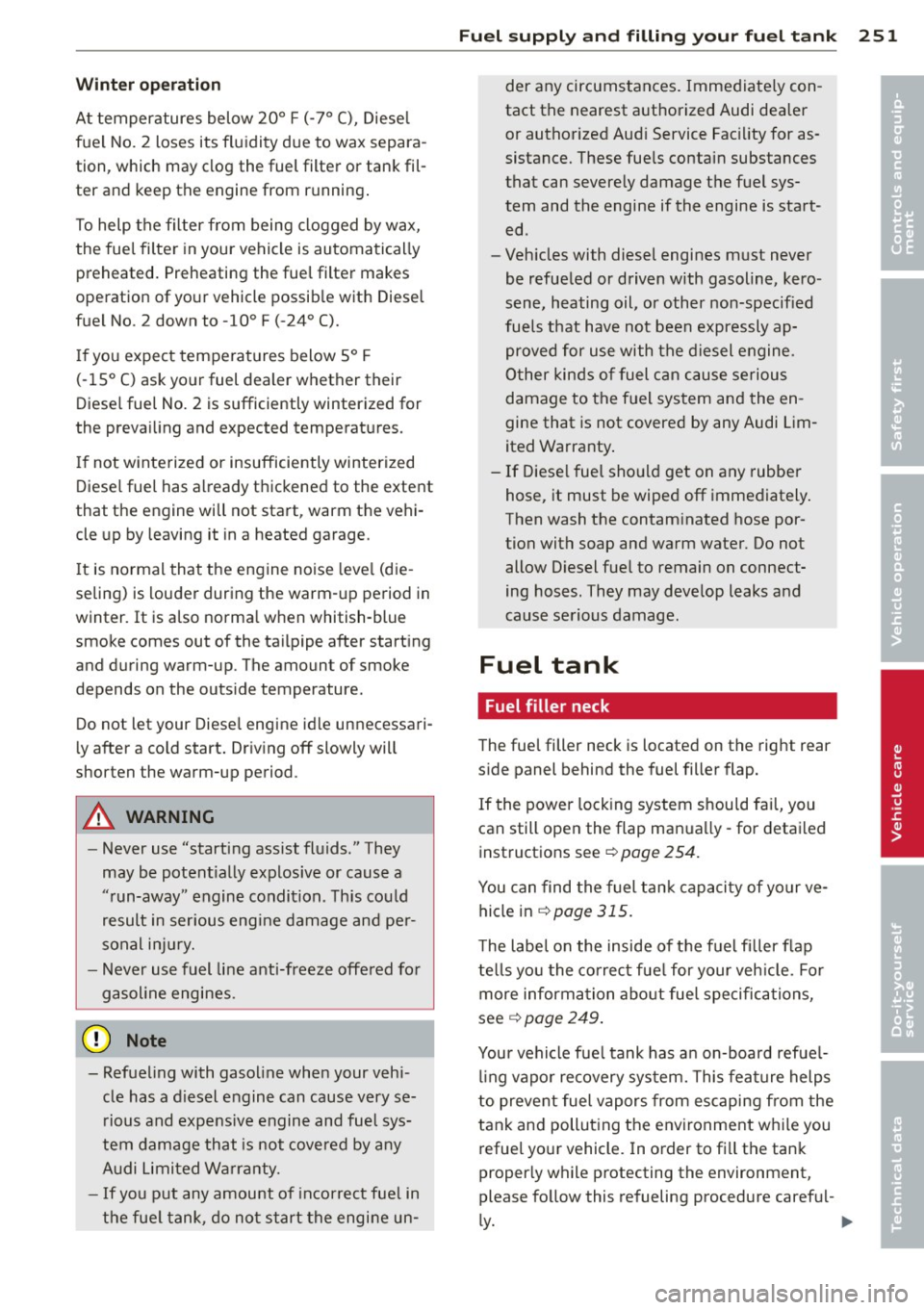
Winter operation
At temperatures below 20° F (-7° C), Diesel
fuel No.
2 loses its fluidity due to wax separa
tion, which may clog the fuel filter or tank fil
ter and keep the engine from running .
To help the filter from being clogged by wax,
the fuel filter in your vehicle is automatically
preheated. Preheating the fuel filter makes
operation of your vehicle possible with Diesel
fuel No . 2 down to -10° F (-24° C).
If you expect temperatures below 5° F
(-15° C) ask your fuel dealer whether their
Diese l fuel No. 2 is sufficiently winterized for
the prevailing and expected temperatures.
If not winterized or insufficiently winterized
Diesel fuel has already thickened to the extent
that the engine will not start, warm the vehi
cle up by leaving it in a heated garage.
It is normal that the engine noise leve l (die
seling) is louder during the warm-up period in
winter.
It is also norma l when whitish-blue
smoke comes out of the tailpipe after start ing
and during warm-up . The amount of smoke
depends on the outs ide temperature.
Do not let your Diese l engine id le unnecessari
ly after a cold start. Driving off slowly will
shorten the warm-up period .
A WARNING
-Never use "starting assist fluids." They
may be potent ially explosive or cause a
"run-away" engine condition. This could
result in serious engine damage and per
sonal injury.
- Never use fuel line anti-freeze offered for
gasoline engines .
0 Note
- Refueling with gasoline when your vehi
cle has a diesel engine can cause very se
rious and expens ive engine and fuel sys
tem damage that is not covered by any
A udi Limited Warranty.
- If you put any amou nt of incorrect fuel in
the fuel tank, do not start the engine un-
-
Fuel supply and filling your fuel tank 251
der any circumstances. Immediately con
tact the nearest authorized Audi dea ler
or authorized Audi Service Fac ility for as
sistance. These fuels contain substances
that can severely damage the fuel sys
tem and the engine if the engine is start
ed .
- Veh icles with diesel engines must never
be refueled or driven with gasoline, kero
sene, heating oil, or other non-specified
fuels that have not been expressly ap proved for use with the diesel engine.
Other kinds of fuel can cause serious
damage to the fuel system and the en
gine that is not covered by any Audi Lim
ited Warranty.
- If Diesel fuel should get on any rubber
hose, it must be wiped off immediately.
Then wash the contaminated hose por
tion with soap and warm water. Do not
allow D iesel fuel to remain on connect
ing hoses . They may develop leaks and
cause serious damage.
Fuel tank
Fuel filler neck
The fuel filler neck is located on the right rear
side panel behind the fuel filler flap.
If the power locking system shou ld fai l, you
can still open the flap manually -for detailed
instructions see¢
page 254.
You can find the fuel tank capacity of your ve
hicle inc::>
page 315.
The label on the inside of the fuel filler flap
tells you the correct fuel for your veh icle. For
more information abo ut fuel specifications,
see c::>
page 249.
Your vehicle fuel tank has an on-board refuel
ling vapor recovery system. This feature helps
to prevent fue l vapors from escaping from the
tank and pollut ing the environment while you
refuel yo ur vehicle. In order to fill the tank
properly while protecting the environment,
please follow this refueling procedure careful-
~-~
•
•
Page 254 of 340

252 Fuel supply and filling your fuel tank
_&. WARNING
Under normal operating conditions, never
carry additional fuel containers in your car .
Gas canisters and other containers used to
transport fuel can be dangerous. Such con
tainers, full or empty, may leak and could
cause afire in a collision. If you must
transport fuel to use for your lawn mower,
snow blower, etc., be very careful and al
ways observe local and state laws regard
ing the use, transportat ion and storage of
such fuel containers. Make certain the con
tainer meets industry standards (ANSI/
ASTM F8S2 -86).
(D Note
Never drive your vehicle until the fuel tank
is completely empty. The irregular supp ly
of fuel can cause misfiring . Gasoline could
enter the exhaust system and damage the
catalyt ic converter.
Refuelling
Fig . 232 Right rear vehicle side : Open ing t he fue l filler
fl ap
Fig. 233 Fu el cap hooked on the opened fue l filler fl ap
When adding fuel, the ignition and any cellu
lar phones in the vehicle must be switched
off . When activating the central locking, the fuel
filler flap is automatically unlocked or
locked. Refuel the vehicle with the ignition
turned
off.
Taking the fuel cap off
.,. To open the fue l filler f lap, press on the left
side of the flap¢
fig. 232 -arrow-.
.,. Unscrew fue l filler cap counter-clockwise
and hang it on the fuel filler flap ¢
fig. 233.
.,. Check the label on the inside of the fuel fill
er flap to determine if the vehicle must be
fueled with gasoline or diesel fuel.
Refuelling procedure
.,. Insert the fuel nozzle from the gasoline
pump into the fuel filler neck as far as it wi ll
go .
.,. Select a medium refuelling rate so that the
nozzle switches off automatically when the
tank is fu ll.
Putting the fuel cap back on
.,. After filling your tank, twist the fuel filler
cap clockwise as far as it wi ll go.
.,. Close the fuel filler flap.
T o avoid fuel spilling or evaporating from the
fuel tank always close fuel filler cap proper ly
and completely. An improperly closed fuel fill
er cap may also cause the MIL lamp¢
page 27
to come on (only vehicles with gasoline en
gine) .
_&. WARNING
Improper refueling or handling of fuel can
cause fire, explosion and severe burns.
- Fuel is highly flammable and can cause
severe bu rns and other injuries.
- Failure to shut the engine off while refu
eling and/or to insert the pump nozzle
fu lly into the fuel filler neck could cause
fuel to spray out of filler neck or to over
f low . Fu el spray and overflowing fue l can
cause a fire.
- Never use a cellular telephone while re
fue ling. The electromagnetic radiat ion
can cause sparks that can ignite fuel va
pors and cause a fire .
Page 255 of 340
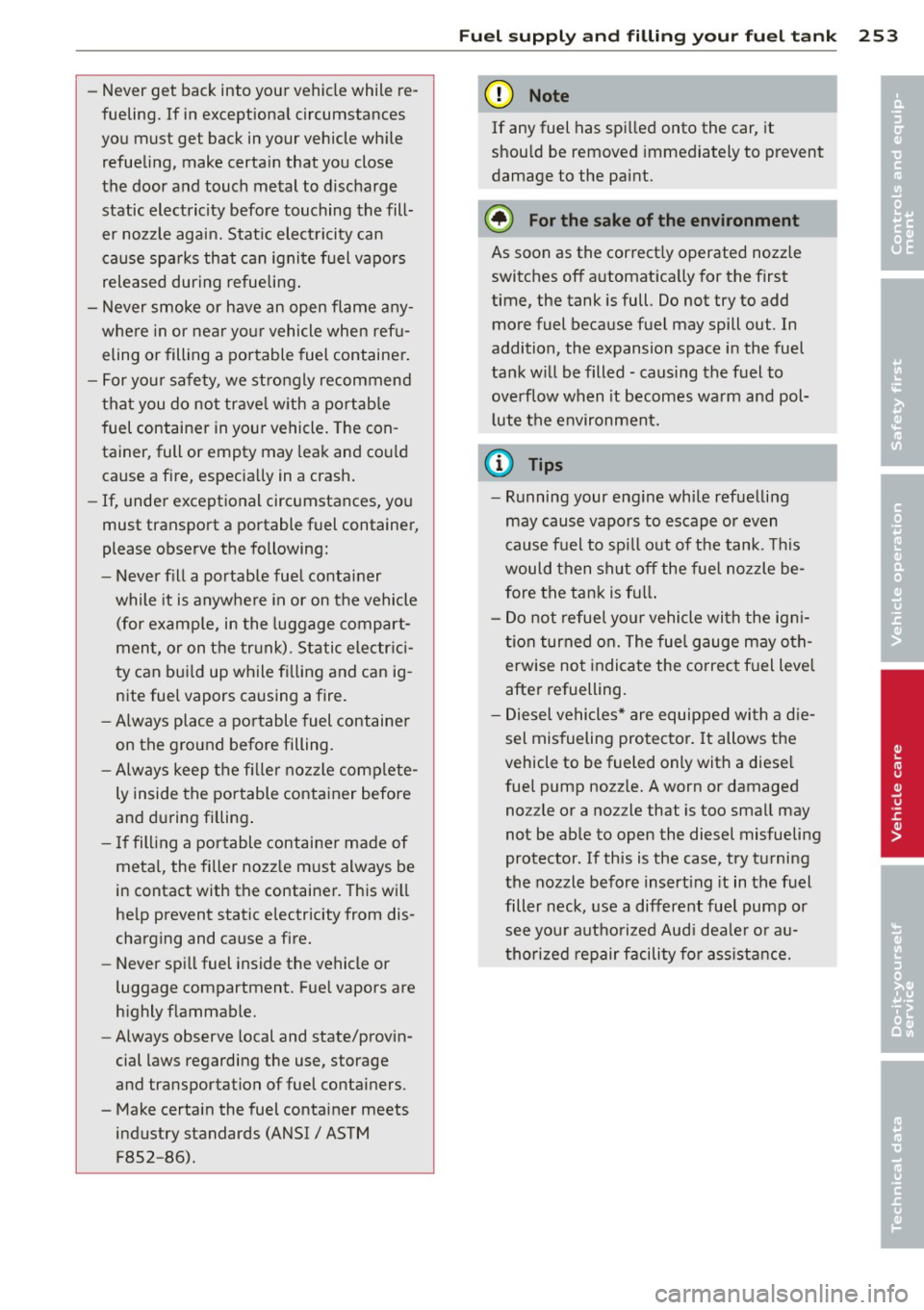
-Never get back into your vehicle while re
fueling. If in exceptional circumstances
you must get back in your vehicle while refueling, make certain that you close
the door and touch metal to discharge
static electricity before touching the fill
er nozzle again. Stat ic electricity can
cause sparks that can ignite fuel vapors
released during refueling .
- Never smoke or have an open flame any
where in or near your vehicle when refu
eling or filling a portable fuel container.
- For your safety, we strongly recommend
that you do not trave l w ith a portab le
fuel container in your vehicle. The con
tainer, full or empty may leak and cou ld
cause a fire, especia lly in a crash .
-If, under exceptional circumstances, you
must transport a portable fuel container,
please observe the following:
- Never fill a portable fuel container
while it is anywhere in or on the vehicle
(for examp le, in the luggage compart
ment, or on the trunk). Static electr ici
ty can bui ld up while fi lling and can ig
nite fuel vapors causing a fire.
- Always p lace a portable fuel container
on the ground before filling.
-Always keep the filler nozzle complete
ly inside the portable container before
and during filling .
- If filling a portable container made of
metal, the filler nozz le must always be
in contact with the container. This will
he lp prevent static electricity from dis
charging and cause a fire.
- Never spill fuel inside the vehicle or
luggage compartment. Fue l vapors are
h ighly flammable.
- Always observe local and state/provin
cial laws regarding the use, storage
and transportation of fuel containers.
- Make certain the fuel container meets
industry standards (ANSI/ ASTM
F852 -86).
Fuel supply and filling your fuel tank 253
@ Note
If any fuel has spilled onto the car, it
shou ld be removed immediately to prevent
damage to the paint.
@ For the sake of the environment
As soon as the correct ly operated nozzle
switches off automat ically for the first
time, the tank is full. Do not try to add
more fuel because fuel may spill out. In
addition, the expansion space in the fuel
tank w ill be filled -causing the fuel to
overflow when it becomes warm and pol
lute the environment.
0) Tips
-Running your eng ine while refuelling
may cause vapors to escape or even
cause fuel to sp ill out of the tank . Th is
would then shut off the fuel nozzle be
fore the tank is ful l.
- Do not refuel your vehicle with the igni
tion turned on. The fuel gauge may oth
erwise not indicate the correct f uel level
after refuelling.
- Diesel vehicles* are equipped with a d ie
sel misfueling protector . It allows the
vehicle to be fueled only with a diese l
fuel pump nozzle. A worn or damaged
nozzle or a nozzle that is too small may
not be able to open the diesel misfueling
protector. If this is the case, try turning
the nozzle before inserting it in the fuel
filler neck, use a different fuel pump or
see your authorized Aud i dea ler or au
thorized repair facility for assistance. •
•
Page 256 of 340
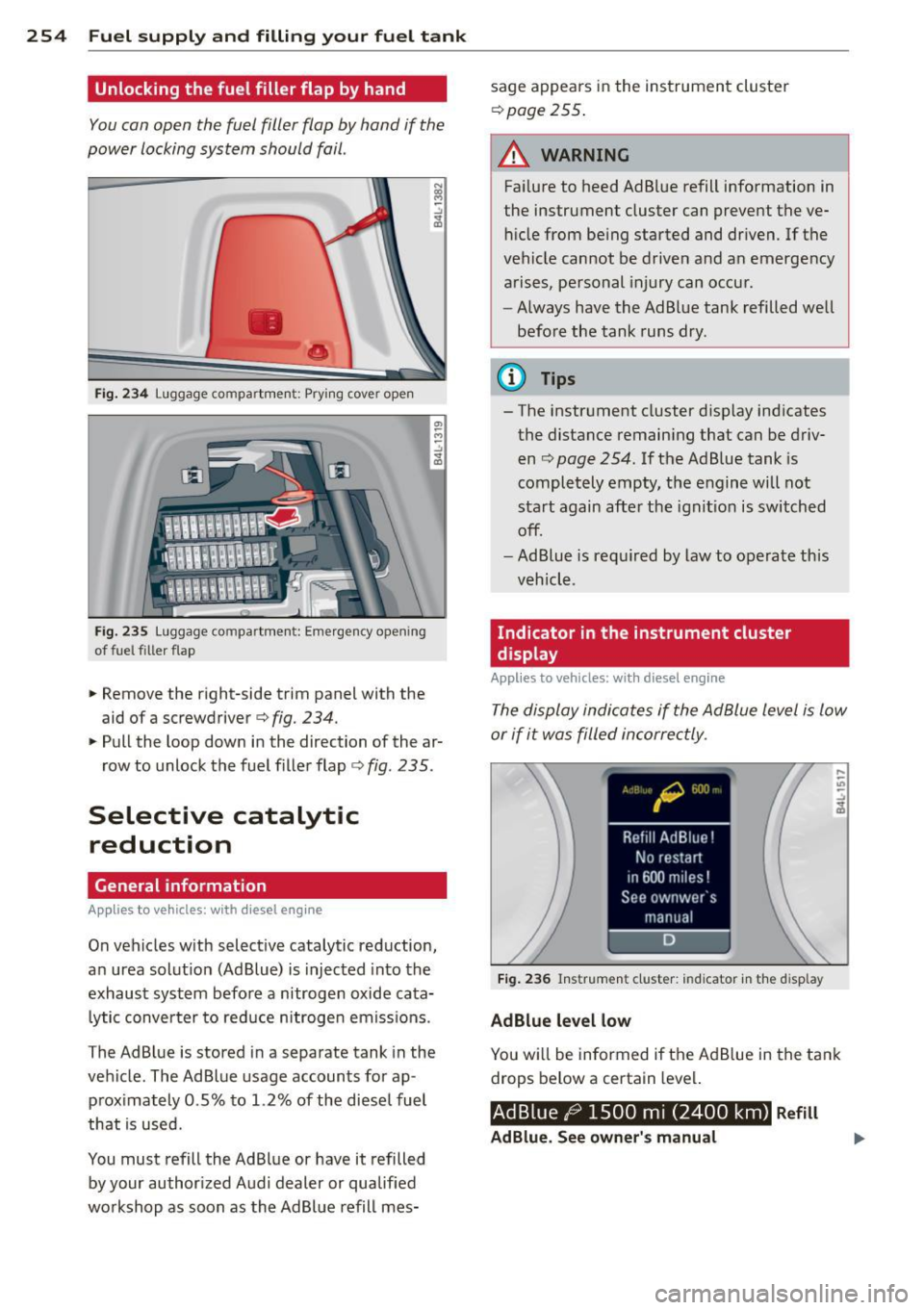
254 Fuel supply and filling your fuel tank
Unlocking the fuel filler flap by hand
You can open the fuel filler flap by hand if the
power locking system should fail .
•
Fig. 234 Luggag e compart men t: Pry ing cover open
Fig. 235 Luggage compartmen t: Eme rgency open ing
of fuel filler flap
.. Remove the right-side trim panel with the
aid of a screwdriver
c:> fig. 234.
.. Pull the loop down in the direction of the ar
row to unlock the fuel f iller flap
c:> fig. 235.
Selective catalytic
reduction
General information
Applies to vehicles: with diesel engine
On vehicles with selective catalytic reduction,
an urea solution (Ad Blue) is injected into the
exhaust system before a nitrogen oxide cata lytic converter to reduce nitrogen emiss ions.
The AdBlue is stored in a separate tank in the
vehicle. The AdBlue usage accounts for ap
proximately 0.5% to 1.2% of the diesel fuel
that is used.
You must refill the Ad Blue or have it refilled
by your author ized Audi dealer or qualified
workshop as soon as the AdBlue refill mes- sage appears
in the instrum ent cluster
r=>page 255.
.&_ WARNING
-
Failure to heed AdBlue refill information in
the instrument cluster can prevent the ve hicle from being started and driven. If the
vehicle cannot be driven and an emergency
arises, personal injury can occur.
- Always have the AdBlue tank refilled well
before the tank runs dry.
(D Tips
- The instrument cluster disp lay ind icates
the distance remaining that can be driv
en
r=> page 254. If the AdBlue tank is
completely empty, the engine will not
start again after the ignit ion is switched
off.
- AdBlue is required by law to operate this
vehicle.
Indicator in the instrument cluster
display
Appl ies to vehicles: with diesel engine
The display indicates if the Ad Blue level is low
or if it was filled incorrectly .
Fig. 236 Instrument cluster: indicator in the display
AdBlue level low
You will be informed if the Ad Blue in the tank
drops below a certain level.
AdBlue l;) 1500 mi (2400 km) Refill
AdBlue. See owner's manual
Page 257 of 340
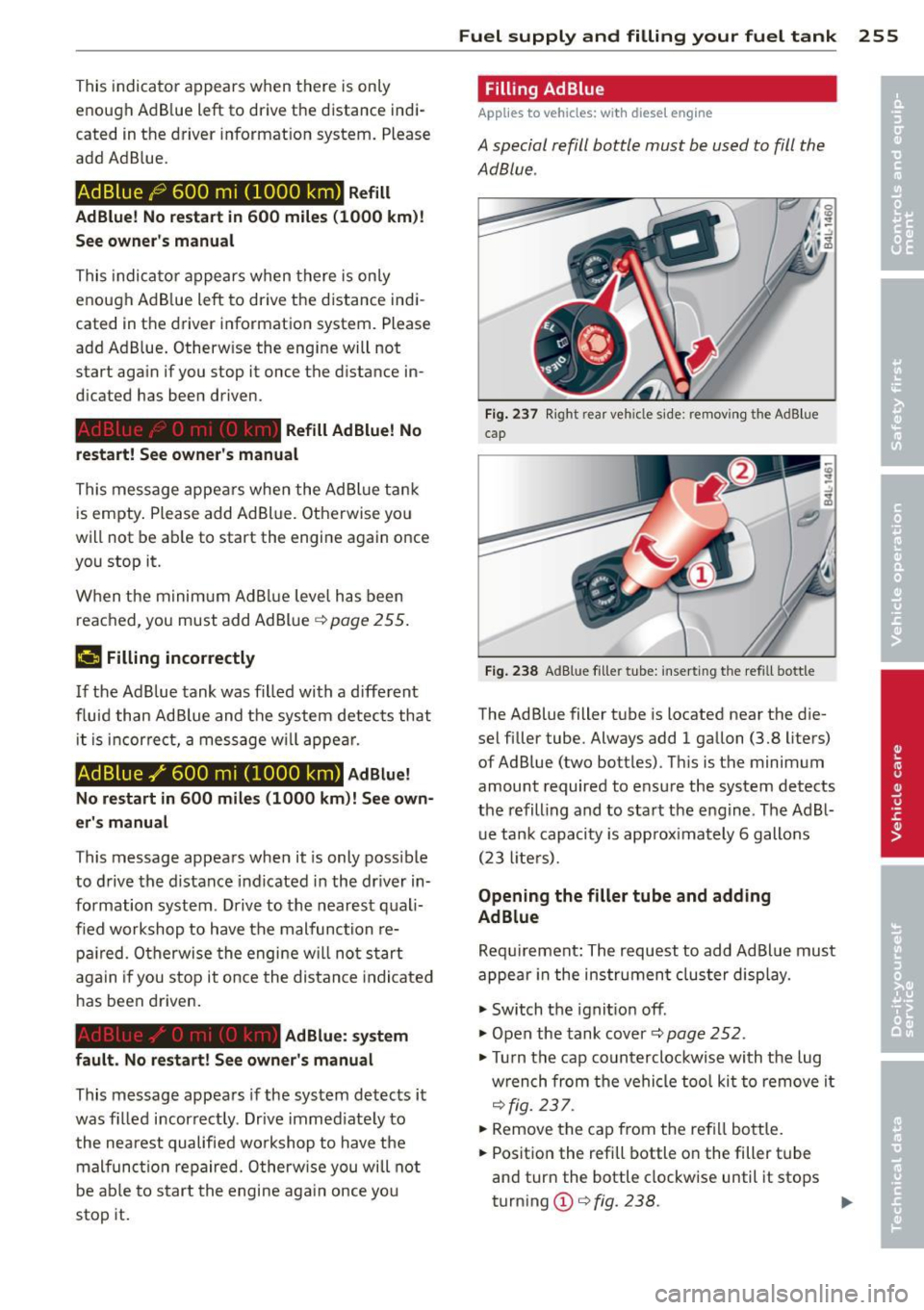
This indicator appears when there is on ly
enough Ad Blue left to drive the distance indi
cated in the driver informat ion system. Please
add Ad B lue.
Ad Blue /9 600 m i (1000 km) Refill
AdBlue! No restart in 600 miles (1000 km )!
See owner's m anual
This indica to r appears when there is on ly
enough Ad Blue left to drive the d istance indi
cated in the driver information system. Please
add Ad B lue . Otherw ise the eng ine will not
start aga in if you stop it once the distance in
dicated has been driven.
Refill AdBlue! No
restart! See owner's manual
This message appea rs when the AdBl ue tan k
is empty . Please add AdBlue. Otherwise yo u
will not be ab le to start the engine again once
you stop it.
When the minim um AdBl ue level has been
reached, you must add Ad Bl ue
q page 255 .
¢'4 Filling incorrectly
If the Ad Blue tank was filled with a diffe rent
f luid than Ad Blue and the system detec ts that
it is i ncor rect, a message w ill appe ar.
AdBlue / 600 mi (1000 km) Ad Blue!
No re start in 600 mile s (1000 km )! See own ·
e r' s manual
This message appea rs when it is only poss ible
to d rive the distance ind icated in the dr iver in
formation system . Drive to the nearest q uali
f ied work shop to have the malfunct ion re
p air ed. Otherwise the engine w ill no t start
again if you stop it o nce the distan ce indi cated
h as been driven.
AdBlue: sy stem
fault . No restart! See owner 's manual
This message appea rs if the system detects it
was fi lled incor rectly . Drive immed iate ly to
t he nea rest qualified wo rkshop to have the
m alf unct io n repaired. Otherw ise you will n ot
be ab le to s tart the engine aga in once yo u
stop it.
Fu el suppl y and filli ng your fuel t ank 255
Filling AdBlue
Applies to vehicles: with diese l engine
A special refill bottle must be used to fill the
AdBlue .
Fig. 23 7 Right rear vehicle side: removing t he AdB lue
cap
Fi g. 23 8 Ad B lue fill er tube: inserting th e refill bottle
The Ad Blue filler tube is located near the d ie
sel filler tube. Always add 1 gallon (3.8 liters)
of Ad Blue (two bott les). T his is the minimum
amount required to ens ure the system detects
the refill ing and to sta rt the e ng ine. The Ad B l
u e tank capacity is app rox imately 6 gallons
( 2 3 lite rs).
Opening the filler tube and adding
Ad Blue
Req uirement: The request to add Ad Blue must
appear in the instrumen t cluster disp lay. •
.,. Switch the ignit ion off .
.,. Open the tank cover
q pag e 2 52.
.. Tu rn the cap co untercloc kwise with the lug
w ren ch from the vehicle too l ki t t o rem ove it
qfig. 237.
.. Remove the ca p from the refi ll bott le.
.. Position the refill bottle o n the filler tube
and turn the bottle clockwise until it stops
turn ing
(D q fig. 238. 1111>
Page 258 of 340
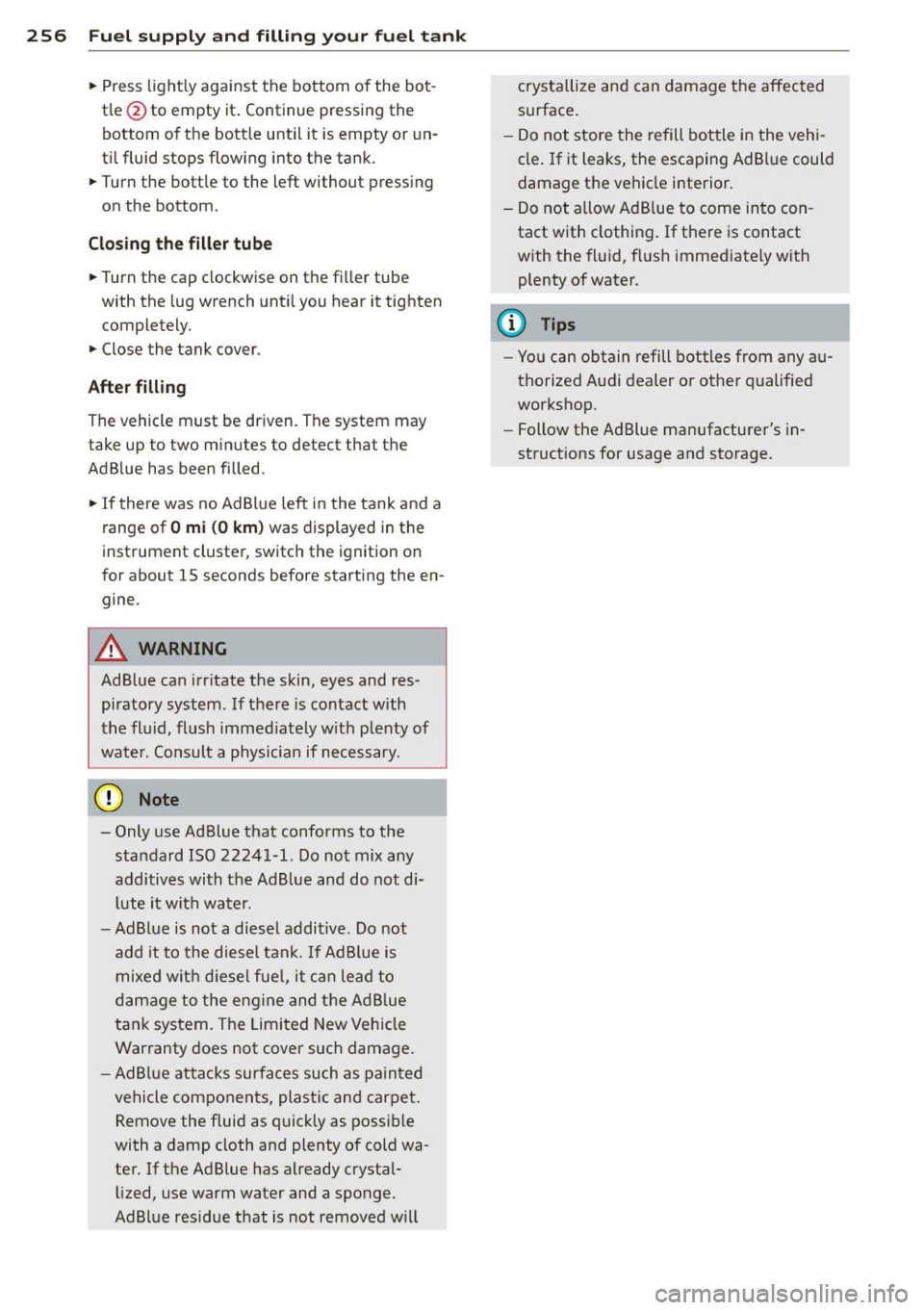
256 Fuel supply and filling your fuel tank
• Press lightly against the bottom of the bot
tle @to empty it. Continue pressing the
bottom of the bottle until it is empty or un
til fluid stops flowing into the tank.
• Turn the bottle to the left without pressing
on the bottom .
Closing the filler tube
• Turn the cap clockwise on the filler tube
with the lug wrench until you hear it tighten
completely.
• Close the tank cover.
After filling
The vehicle must be driven. The system may
take up to two minutes to detect that the
Ad Blue has been filled.
• If there was no Ad Blue left in the tank and a
range of
O mi (0 km) was displayed in the
instrument cluster , switch the ignition on
for about 15 seconds before starting the en
gine.
A WARNING
, -
AdBlue can irritate the skin, eyes and res-
piratory system. If there is contact with
the fluid, flush immediately with plenty of
water. Consult a physician if necessary.
Q) Note
- Only use Ad Blue that conforms to the
standard ISO 22241-1. Do not mix any
additives with the Ad Blue and do not di lute it with water.
-AdBlue is not a diesel additive . Do not
add it to the diesel tank. If Ad Blue is
mixed with diesel fuel, it can lead to
damage to the engine and the Ad Blue
tank system. The Limited New Vehicle
Warranty does not cover such damage.
- Ad Blue attacks surfaces such as painted
vehicle components, plastic and carpet. Remove the fluid as quickly as possible
with a damp cloth and plenty of cold wa
ter. If the Ad Blue has already crystal lized, use warm water and a sponge.
AdBlue residue that is not removed will crystallize and can damage the affected
surface.
- Do not store the refill bottle in the vehi
cle. If it leaks, the escaping Ad Blue could
damage the vehicle interior.
- Do not allow Ad Blue to come into con
tact with clothing. If there is contact
with the fluid, flush immediately with
plenty of water.
(D Tips
- You can obtain refill bottles from any au
thorized Audi dealer or other qualified
workshop .
- Follow the Ad Blue manufacturer's in
structions for usage and storage.
Page 260 of 340
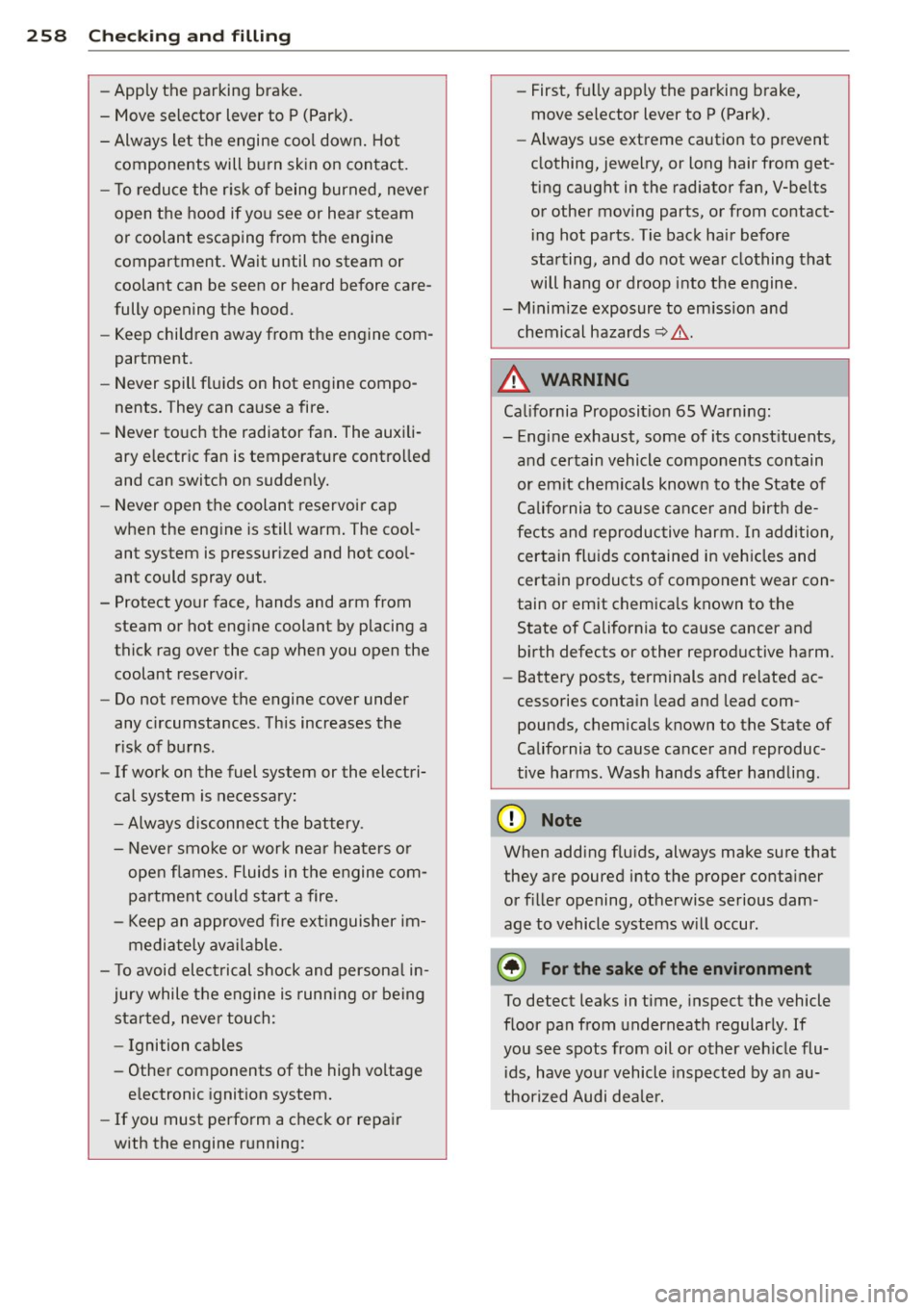
258 Checking and filling
-Apply the parking brake.
- Move selector lever to P (Park).
- Always let the engine cool down. Hot
components will burn skin on contact.
- To reduce the risk of being burned, never
open the hood if you see or hear steam
or coolant escaping from the engine
compartment. Wait until no steam or
coolant can be seen or heard before care
fully opening the hood.
- Keep children away from the engine com
partment.
- Never spill fluids on hot engine compo
nents. They can cause a fire.
- Never touch the radiator fan. The auxili
ary electric fan is temperature controlled
and can switch on suddenly.
- Never open the coolant reservoir cap
when the engine is still warm. The cool
ant system is pressurized and hot cool
ant could spray out.
- Protect your face, hands and arm from
steam or hot engine coolant by placing a
th ick rag over the cap when you open the
coolant reservoir .
- Do not remove the engine cover under
any circumstances. This increases the
risk of burns.
- If work on the fuel system or the electri
cal system is necessary:
- Always disconnect the battery .
- Never smoke or work near heaters or
open flames. Fluids in the engine com
partment could start a fire.
- Keep an approved fire extinguisher im
mediately available.
- To avoid electrical shock and personal in
jury while the engine is running or being
started, never touch:
- Ignition cables
- Other components of the high voltage
electronic ignition system.
- If you must perform a check or repair
with the engine running: -
First, fully apply the parking brake,
move selector lever to P (Park).
- Always use extreme caution to prevent
clothing, jewelry, or long hair from get
ting caught in the radiator fan, V-belts
or other moving parts, or from contact ing hot parts. Tie back hair before
starting, and do not wear clothing that
will hang or droop into the engine.
- Minimize exposure to emission and chemical hazards
~ &, .
A WARNING
=
California Proposition 65 Warning:
- Engine exhaust, some of its constituents, and certain vehicle components contain
or emit chemicals known to the State of
California to cause cancer and birth de
fects and reproductive harm. In addition,
certain fluids contained in vehicles and
certain products of component wear con
tain or emit chemicals known to the
State of California to cause cancer and
birth defects or other reproductive harm.
- Battery posts, terminals and related ac
cessories contain lead and lead com
pounds, chemicals known to the State of
California to cause cancer and reproduc
tive harms. Wash hands after handling.
(D Note
When adding fluids, always make sure that
they are poured into the proper container
or filler opening, otherwise serious dam
age to vehicle systems will occur.
@) For the sake of the environment
To detect leaks in time, inspect the vehicle
floor pan from underneath regularly. If
you see spots from oil or other vehicle flu ids, have your vehicle inspected by an au
thorized Audi dealer.
Page 263 of 340
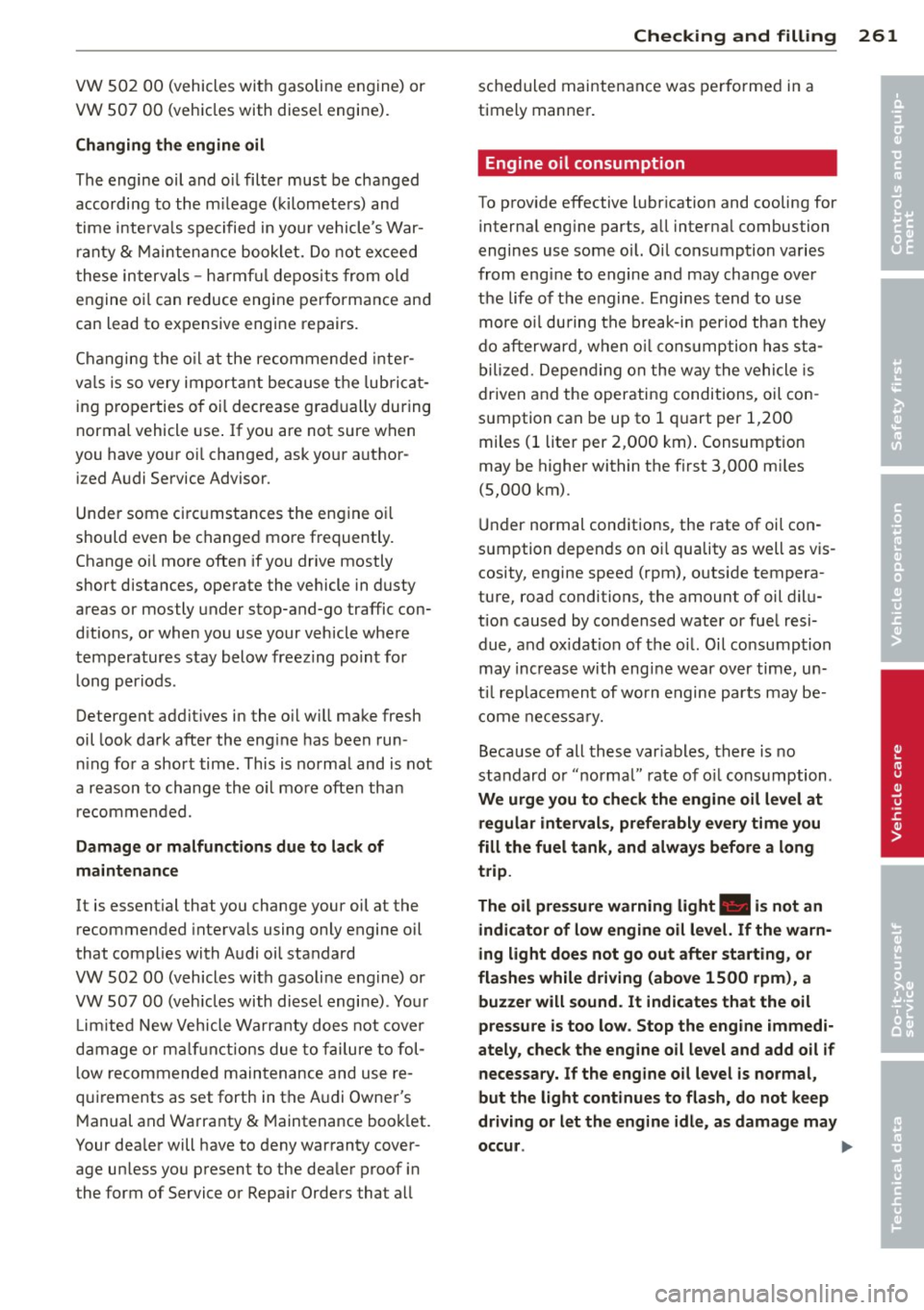
VW 502 00 (vehicles with gasoline engine) or
VW
507 00 (vehicles with diesel engine).
C han gin g the en gin e o il
The engine oil and oil filter must be changed
according to the m ileage (ki lomete rs) and
time inte rva ls specified in your vehicle 's War
r anty
& M aintenance booklet. Do not ex ceed
t hese intervals -harmf ul depos its from old
engine oi l can reduce engine performance and
can lead to expensive engine repairs.
Changing the o il at the recommended inte r
va ls is so very important because the lub ric at
ing p roperties o f oi l decrease grad ually during
norma l vehicle use . If you are not sure when
you have yo ur oi l changed, ask your a uthor
ized A udi Service Advisor.
Unde r some ci rc u mstances the engine o il
should even be changed more frequently.
Change o il more often if you drive mostly
short distances, operate the vehicle in dusty
areas or mostly under stop-and-go traffic con
d itions, or when you use your vehicle where
temperatures stay below freezing po int for
l ong periods .
Detergent addit ives in the o il w ill make fresh
oil look dark after the eng ine has been run
ni ng fo r a short time . This is no rmal and is not
a reason to change the o il mo re often than
r ec om mended.
Damage or malfun ctions due to lack of
maintenance
It is essential that yo u change your oil at the
recommended interva ls using only engine oil
that complies with Audi oi l standard
VW
502 00 (vehicles with gasoli ne engine) or
VW
507 00 (veh icles with diesel engine) . You r
Lim ited New Vehicle Wa rra nty does not cove r
damage or m alfu nct ions due to f ailure to fol
l ow recommended maintenance and use re
q uir ements as set forth in the A udi Owner's
M anual and Warranty
& M aintenance book let.
Your dea ler will have to deny warranty cover
age un less you present to the dea ler proof in
the form of Service or Repa ir Orders that all
Checkin g and fillin g 261
scheduled maintenance was performed in a
timely manner.
· Engine oil consumption
To provide effective l ubr ication and cooling for
interna l eng ine parts, all interna l combustion
engines use some oi l. Oi l consumption varies
from eng ine to engine and may change over
the life of the engine . Engines tend to use
more o il du ring the b reak-in period tha n they
do afterward, when o il cons umption has sta
bilized. Depend ing on the way the vehicle is
driven and the operating conditions, oil con
s u mption can be up to
1 quart per 1,200
miles (l liter per 2,000 km) . Consumption
may be higher within the first
3,000 m iles
(5,000 km) .
U nder normal conditions , the rate of oi l con
s u mption depends on oi l quality as well as vis
cosity, engine speed (rpm), outs ide tempera
ture, road conditions, the amount of oil dilu
tion caused by condensed water or fue l resi
due, and ox idat ion of the o il. Oi l consumption
may increas e with eng ine wear over time, un
t il rep lacement of worn engine pa rts may be
come ne cessa ry.
Because of all these var iables, there is no
standard o r "n orma l" rate of o il cons umption .
We urge you to check the engine oil level at
regular interval s, preferably every time y ou
fill the fuel t ank, and always before a long
trip .
The oil pres sure warning light. i s not an
indicator of low engine oil level. If the warn
ing light does not go out after starting, or
flashes while dr iving (above 1500 rpm), a
buzzer will sound. It indicate s that the oil
pressure is too low . Stop the engine immedi
ately , check the engine oil level and add oil if
necessa ry. If the engine oil level is normal,
but the l ight continues to fla sh, do not keep
driving or let the engine idle, as damage may
occur .
IIJ,
•
•
Page 264 of 340
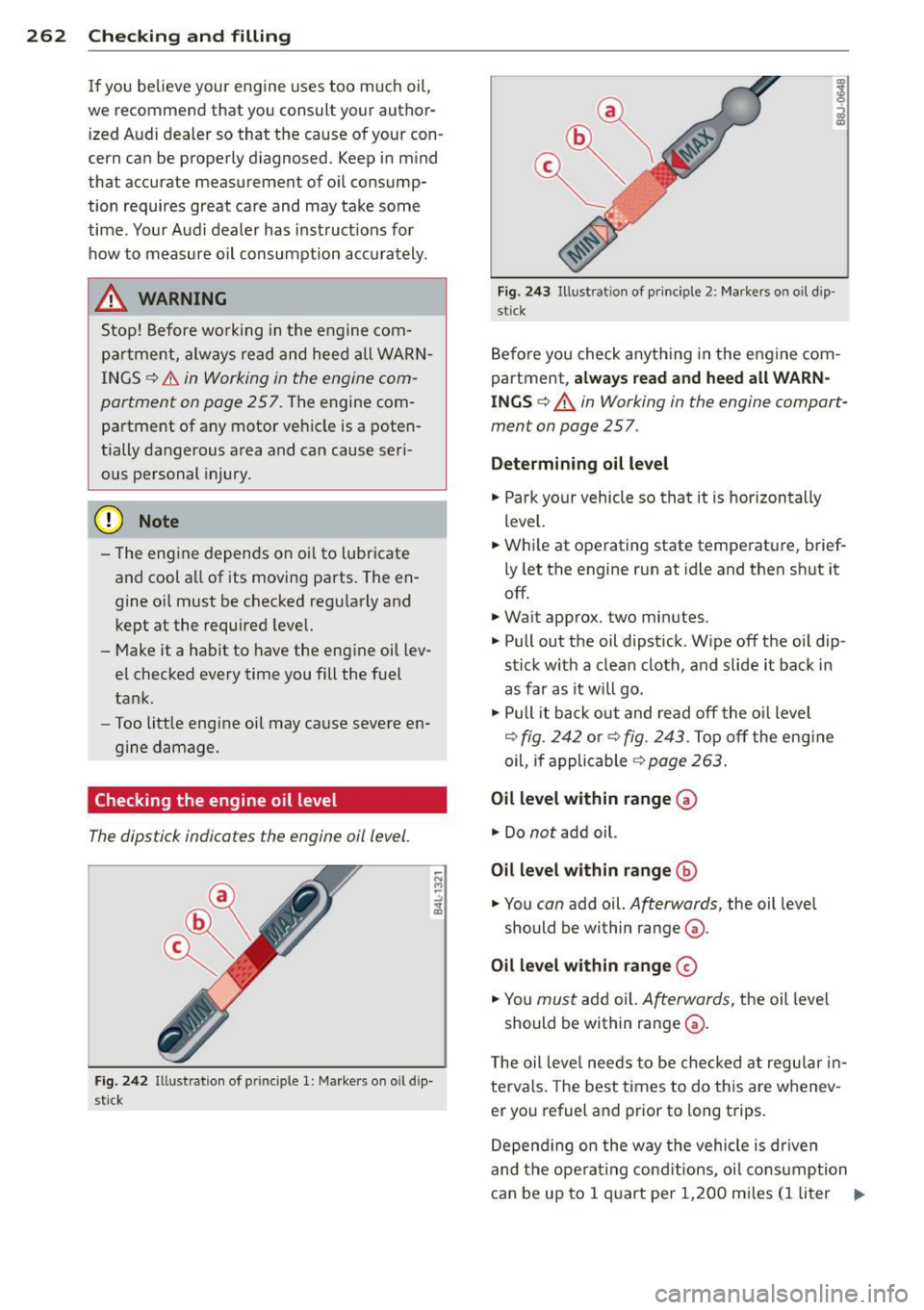
262 Checking and filling
If you believe your engine uses too much oil,
we recommend that you consult your author
ized Audi dealer so that the cause of your con
cern can be properly diagnosed. Keep in m ind
that accurate measurement of oil consump
tion requires great care and may take some
time. Your Audi dealer has inst ruct ions for
how to measure oil consumption accurately .
_& WARNING
Stop! Before working in the engine com
pa rtment, always read and heed all WARN
INGS
9 .&. in Working in the engine com
partment on page 257.
The engine com
partme nt of any motor veh icle is a poten
tially dangerous area and can cause ser i
ous personal injury.
(D Note
- The eng ine depends on oi l to Lubricate
and cool a ll of its moving parts . The en
gine oil must be checked reg ularly and
kept at the required level.
- Make it a habit to have the engine oil Lev
el checked every time you fill the fuel
tank.
- Too little engine oi l may ca use severe en
gine damage.
Checking the engine oil level
The dipstick indicates the engine oil level.
F ig. 2 42 Illustrat ion of p rincip le 1: Ma rkers o n oil dip·
st ick
Fig. 243 Illust ratio n of p rinciple 2: Ma rke rs on oil d ip ·
s ti ck
Befo re you check a nyth ing in the engine com
partment,
alway s read and heed all WARN
INGS 9 A in Working in the engine compart
ment on page 257 .
Determining oil level
.,. Park your vehicle so tha t it is horizontally
Level.
.,. Whi le at operating state temperature, br ief
ly let the engine run at idle and then shut it
off.
.,. Wait approx. two minutes .
.,. Pull out the oil d ipst ick . W ipe off the oil dip
st ick w ith a clean cloth, and slide it back in
as far as it wi ll go.
.,. Pull it back out and read off the o il Level
r=.> fig. 242 or 9 fig. 243. Top off the eng ine
oil, if applicable
9 page 263 .
Oil level within range@
.,. Do not add oil.
Oil le vel within r ange @
.,. You can add oil. Afterwards, the oil leve l
should be within range
G) .
Oil lev el within rang e 0
.,. Yo u must add oil. Afterwards, the oil leve l
should be within range
G) .
The oil leve l needs to be checked at regular in
terva ls. The best times to do this are whenev-
er you refuel and prior to Long trips .
Depend ing on the way the vehicle is dr iven
and the opera ting cond it ions, oi l cons umption
can be up to 1 quart per 1,200 mi les (1 liter ..,.
Page 276 of 340
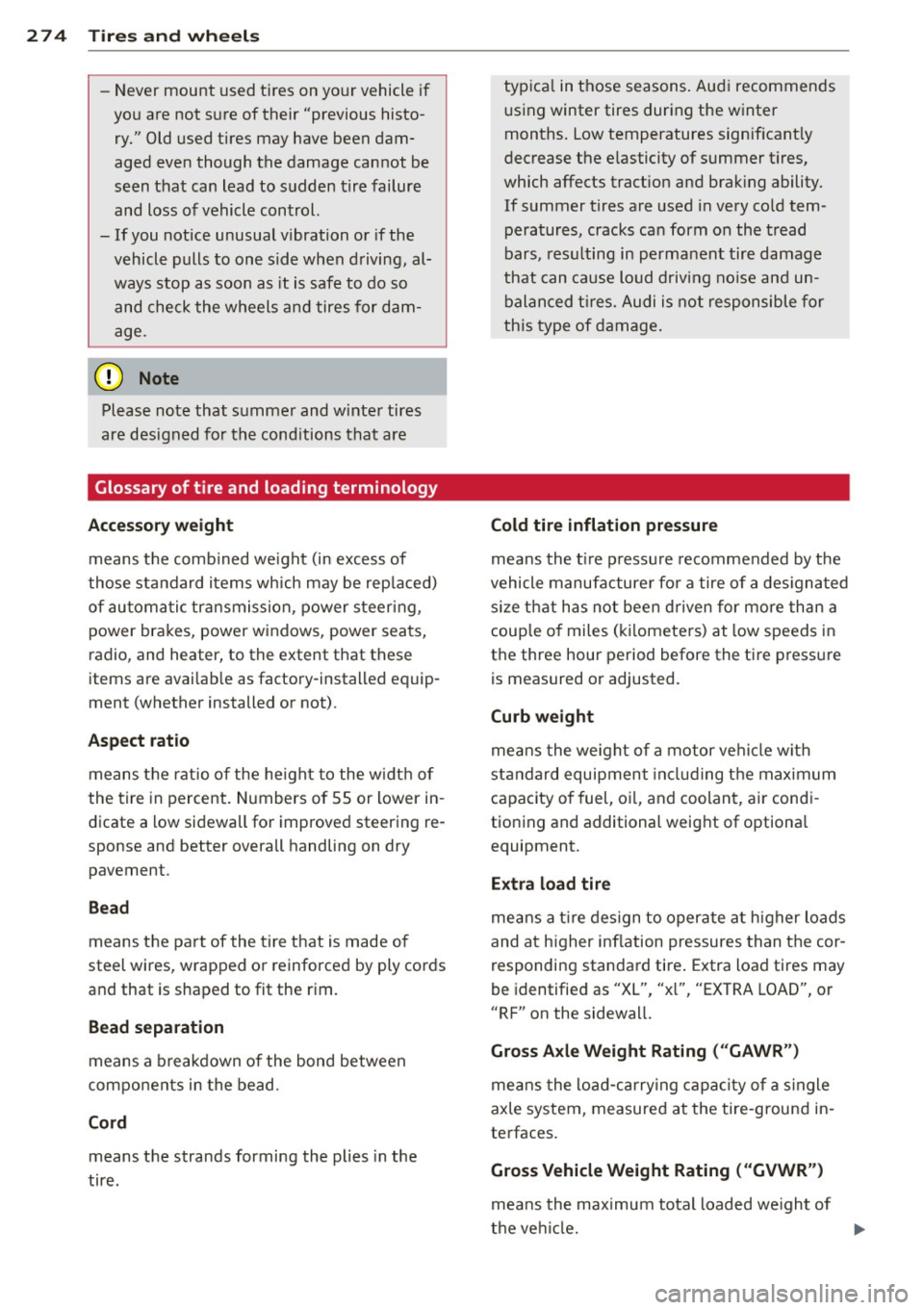
274 T ire s and wheel s
-Never mount used tires on yo ur vehicle if
you are not sure of their "previous histo
ry." Old used tires may have been dam
aged even though the damage cannot be
seen that can lead to sudden t ire failure
and loss of vehicle control.
- If you notice unusual vibration or if the
vehicle pulls to one side when driving, al
ways stop as soon as it is safe to do so
and check the wheels and tires for dam
age.
(D Note
Please note that summer and winter tires
are designed for the cond itions that are
Glossary of tire and loading terminology
Accessory weight
means t he comb ined we ight (in excess of
those sta ndard items which may be rep laced)
of au toma tic tra nsmission, power steer ing,
power brakes, power windows, power seats,
radio, and heater, to the extent that th ese
items are availab le as factory -installed equip
ment (whether installed or not) .
Aspect ratio
means t he ratio of the he ight to the w idth of
the tire in percent . Numbers of 55 or lower in
dicate a low sidewall for improved steering re
sponse and better overall handling on dry pavement .
Bead
means the part of the ti re that is made of
steel wires, wrapped or reinforced by ply cords
and that is shaped to fit the rim.
Bead separation
means a b reakdown of the bond between
components in the bead.
Cord
means the strands forming the plies in the
tire . typ
ica l in those seasons . Audi recommends
using winter tires during the winter
months . Low temperatures signif icant ly
decrease the e lasticity of summer tires,
which affects tract ion and brak ing ability.
If summer tires are used in very co ld tem
peratures, cracks ca n form on the tread
bars, res ulting in permanent tire damage
that can cause loud driving no ise and un
balan ced t ires. Audi is not responsible for
th is type of damage .
Cold tire inflation pressure
means the tire p ressu re recommended by t he
vehicle manufacturer fo r a tire of a des igna ted
s iz e that has not bee n driven for more than a
coup le of miles (k ilometers) at low speeds in
t h e three hour period before the tire pressure
is measured or adjusted.
Curb weight
mea ns the we ight of a motor ve hicl e w ith
standard equipment including the max imum
capacity of fuel, oil, and coolant, air condi
tioning and additional weight of optiona l
equipment.
Extra load tire
me ans a t ire design to operate at higher loads
and at h igher inflation pressures than the cor
responding standard tire . Extra load tires may
be identified as "XL", "x l" , "EXTRA LOAD", or
"RF" on the sidewall.
Gross A xle Weight Rating ("GAWR ")
means the lo ad -c a rry ing c apac ity of a s ingle
axle system , measured a t the tire-ground in
terfaces.
Gross Vehicle Weight Rating ("GVWR ")
mea ns the maximum total loaded we ight of
t h e ve hicl e. .,.